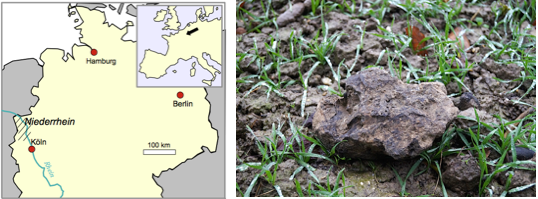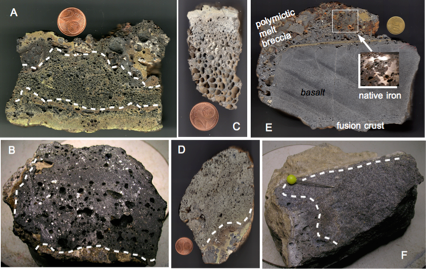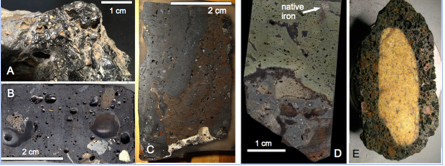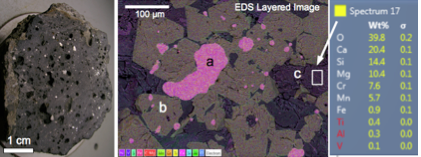49th Lunar and Planetary Science Conference 2018 (LPI Contrib. No. 2083) 1610.pdf
THE ENIGMATIC NIEDERRHEIN
(GERMANY) DEPOSIT: EVIDENCE OF A MIDDLE-PLEISTOCENE METEORITE IMPACT STREWN
FIELD G. Waldmann1, F. Herten2, K.
Ernstson3, 1Haus
der Natur, Kloster Knechtsteden, 51540 Dormagen, Germany
(georg.waldmann@gmx.net), 2ENERKO INFORMATIK GmbH, Markt 45-47, 52062 Aachen, Germany
(friedel.herten@enerko-informatik.de), 3Faculty of Philosophy I, University of
Würzburg, 97074 Würzburg, Germany (kernstson@ernstson.de).
Introduction: In the last years during intense geologic field work on the Pleistocene in the Niederrhein district (Fig. 1) author G.W. regularly picked up conspicuous rocks of quite different form, material and facies, which appeared to belong to a common incidence but which however had never before been given consideration by local and regional geologists, not to mention any reference in the literature. Together with author F.H. and over time the sampled rock mass as well as the affected sample area increased. Likewise, with regard to the established geology in the Niederrhein district, the conviction of a strange geologic process and origin arose. Here we report on a provisional model for the origin of this enigmatic deposit that far from having clarified all observations and understanding the complete context focuses on an extraterrestrial component in the form of a probable meteorite impact event.

Fig. 1. Location map. Fig. 2. Typical find in the field.
Geologic setting and sample conditions: The finds of the sharp-edged rocks under discussion concentrate on pit mines of fossil river terraces about 30 m below the present landscape and contrast markedly with the exploited well-rounded gravel material. Surface finds (Fig. 2) in more than 40 localities in the open landscape on eroded slopes are meanwhile completing the occurrence.
In the beginning the rocks attracted attention because of their basically basaltic and frequently observed melt rock character. The sharp-edged basalts on the one hand were puzzling because the nearest basalt natural occurrences were about 100 km distant, and fluvial and glacial transport because of the sharpness of the fractured basalts could reasonably be questioned. More startling was the observation of abundant native iron in the basalts in the form of both metallic spherules and irregularly shaped inclusions. Native iron in basalt is well known from Greenland deposits [1] but otherwise is extremely rare on Earth. One of these rare occurrences (Bühl) was exploited until the early 20th century near the city of Kassel, but the distance to the Niederrhein location is roughly 200 km practically excluding a direct connection. Apart from these early considerations the further preoccupation with the enigmatic rocks featured more and more surprising observations, which, at first vaguely, reminded of a meteoritic context and which is described in more detail below.
The peculiar rocks – form and material: Apart from heavy chunks of pure iron the basic group of rocks and in the field most noticeable are basaltic cobbles and boulders weighting up to 10 kg with in most cases a contrasting fusion crust of variable appearance (Fig. 3, 4). The basaltic core may be widely untouched (Fig. 3) or has changed to an in part strongly vesicular melt rock (Fig. 4). The fusion crust is monomictic basaltic, polymictic brecciated or pure glass (Fig. 5). The black fusion crust in Fig. 4 is a polymictic melt rock containing various vesicular glass fragments in a vesicular glass matrix (Fig. 4A, B). The thickness of the fusion crust varies between the order of a millimeter (Fig. 3F, 3A) and a few centimeters (Fig. 3C, E). Fig. 3C shows continuously decreasing vesicle size changing into a dense glass crust with Mohs scale 7. Special forms are polymictic melt rocks with flow texture (Fig. 4C, D) or glass-bearing sedimentary rocks (e.g. quartzites) enwrapped with a polymictic, mostly basaltic fusion crust (Fig. 4E). Frequently sedimentary matter containing calcite and quartz is attached to the fusion crust (Fig. 6).

Fig. 3. Typical basaltic rocks with fusion crusts from the Niederrhein deposit (see text).
Conspicuously paired combinations of basically different rock types are shown in Fig. 5. In relation to common meteoritic texture but for now genetically irrelevant we define „chondritic“ and „achondritic“ breccias in contact with basaltic rock. The polymictic „chondritic breccia“ (Fig. 5B, C) forms the crust of a slightly vesicular basalt while conversely the polymictic, metal-rich „achondritic breccia“ has a vesicular basaltic crust (Fig. 5A).

Fig. 4. Special types of melt rock from the Niederrhein deposit (see text).
Resembling the „achondritic breccia“ a distinct group of pebbles abundantly found in the field has a regmaglyptic sculpture, varying metal content and brazen yellow granulous patina (Fig. 6C). Eye-catching are sharp-edged basalt samples with fusion crust that must have formed after fracturing (Fig. 6A), and samples with regmaglyptic sculpture (Fig 6B).

Fig. 5. „Chondritic“ and „achondritic“ breccias in contact with basaltic rock (see text).

Fig. 6. A: Fusion crust coating sharp-edged fractured basaltic rock. B: Regmaglyptic sculpture. C: „Achondritic“ pebbles (see text).
The native iron in the form of spherules and irregularly shaped particles shows a broad spectrum of size (micrometers up to centimeters) and distribution within the sampled rocks (basaltic matrix and fusion crust, Fig. 7, 3E).

Fig. 7. Various formations of native iron in basalt. sed = sedimentary breccia material contacting and intruding a basaltic cobble.
Looking into the samples – EBCD, SEM-EDX and petrographic slides: Preliminary results of SEM analyses of a basaltic melt rock (Fig. 8) with metallic inclusions show an extremely complex composition, and it is not always conclusive for now whether we are dealing with original basaltic matter or recrystallized melt rock. In a small segment of the sample the EDS Layered Image (Fig. 8) basically distinguishes three different fields: metallic inclusions composed of Fe, Ni, Cr and Mn (a), mineral grains belonging to the spinel group (b, mostly probably Cr-Mn spinel), and mineral grains near the pyroxene group (c). Spectra from other spots in the samples may reveal considerably different composition. Likewise, studies of thin sections of other samples from the deposit show strong variations of the mineralogical composition.

Fig. 8. EBSD analysis of a basaltic melt rock (see text).
In the basaltic matter typical shock-metamorphic effects are frequently observed in feldspars in the form of diaplectic glass (maskelynite) and planar deformation features (PDF) (Fig. 9B, C). Diaplectic silica glass from former quartz grains as a strong shock indicator is found in the sedimentary matter contacting basaltic samples (Fig. 9A).

Fig. 9. Photomicrographs of shock metamorphism. Quartz (A) and feldspar (B) grains completely transferred to diaplectic glass., plane light and crossed polarizers. C: Multiple sets of planar deformation features (PDF) in feldspar, plane light.
Conclusions: The presented material suggests a hitherto unseen major geologic alien element in the Niederrhein region primarily based on the ample occurrence of native iron-bearing basaltic melt rocks completely detached from any known basalt deposit up to a distance of 100 km. An origin as basaltic meteorites and achondrites with few attached chondritic matter from Moon, Mars or an asteroid (e.g., Vesta with a basaltic crust) appears reasonable [2] if we assume that the samples were originally launched from the Moon or other cosmic bodies by impacts, which explains the melt and breccia texture and the shock effects in the samples [3]. Details of this proposed event remain enigmatic because a simple meteorite fall does not match some observations. These are, e.g., the often intertwined sedimentary and, hence, probably terrestrial rock components (Fig. 4, /7) with in part strong shock effects suggesting a related terrestrial impact event that from the local geologic stratigraphy should have happened in the Middle-Pleistocene (Cromer) about 600 ka BP:The search for a related morphological impact signature is at the beginning, and the forthcoming fieldwork will also include possible industrial and archeological aspects of the finds. An Ar-Ar dating has been initiated which could significantly substantiate our hypothesis.
References: [1] Bird, J.M. et al. (1981) J. Geophys. Res., 86, 11787-805. [] Martin et al. (2017) Meteoritics Planet. Sci., 52, 1103-1124. [3] https://curator. jsc.nasa.gov/antmet/lmc/lmc.cfm, accessed 1/6/18.